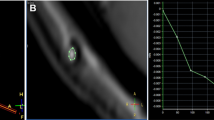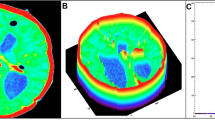Abstract
Shunt malfunction is common and its diagnosis may require invasive testing that may be inaccurate or result in complications. Magnetic resonance imaging (MRI) may prove to be a useful noninvasive test of shunt function as it has been shown that MRI is capable of measuring cerebrospinal fluid (CSF) flows from 2 ml/h to 40 ml/h in model systems. Since flows in functioning shunt systems can be less than 2 ml/h, MRI must be sensitive enough to detect flow in this range in order to be a valid test for shunt function. Continuing previous studies, we have studied MRI flow-related enhancement at flow rates from 0 to 2 ml/h. Multiple spin echo scans (TR2000, TE20) were made through a specialized section of tubing in a model shunt system. The intensity of the MRI signal at points known to demonstrate maximal flow-related enhancement was measured. A linear relationship was demonstrated between signal intensity and flow as low as 0.8 ml/h. These results add support to the concept that MRI is sensitive enough to detect the lowest flows present in functioning shunt systems and therefore may be useful as a noninvasive test of shunt function.
Similar content being viewed by others
References
Bradley WG Jr (1988) Flow phenomenon in MR imaging. AJR 150: 983–994
Bradley WG Jr, Waluch V, Lai KS, Fernandez EJ, Spalter C (1984) The appearance of rapidly flowing blood on magnetic resonance images. AJR 143:1167–1174
Bradley WG Jr, Kortman KE, Burgoyne B (1986) Flowing cerebrospinal fluid in normal and hydrocephalic states: appearance on MR images. Neuroradiology 159: 611–616
Citrin CM, Sherman JL, Gangarosa RE, Bowen BJ (1986) Physiology of the CSF flow-void sign: modification by cardiac gating. AJNR 7: 1021–1024
Frank E, Buonocore M, Hein L (1990) The use of magnetic resonance imaging to assess slow fluid flow in a model cerebrospinal fluid shunt system. Br J Neurosurg 4: 53–58
Hoffman HJ, Smith MSM (1986) The use of shunting devices for cerebrospinal fluid in Canada. Can J Neurol Sci 13: 81–87
Howman-Giles R, McLaughlin A, Johnston I, Whittle I (1984) A radionucleotide method of evaluating shunt function and CSF circulation in hydrocephalus. J Neurosurg 61: 604–605
Martin AJ, Drake JM, Lemaire C, Henkelman RM (1989) Cerebrospinal fluid shunts: flow measurements with MKR imaging. Radiology 173: 243–247
Matsumatae M, Murakami T, Ueda M Suzuki Y, Sato O (1987) Dynamic changes of cerebrospinal fluid shunt flow in patients' daily life. Child's Nerv Syst 3: 30–34
Mills CM, Brant-Zawadzki M, Crooks LE Kaufman L, Sheldon P, Norman D, Bank W, Newton TH, (1984) Nuclear magnetic resonance: principles of blood flow imaging. AJR 142: 165–170
Page LK, Black AR (1985) Proximal catheter obstruction of valved cerebrospinal fluid shunting systems. In: Humphreys RP (ed) Concepts in pediatric neurosurgery, vol 5. Karger, New York, pp 75–83
Raimondi AJ (1987) Pediatric neurosurgery. Theoretical principles, art of surgical techniques. Springer, New York Berlin Heidelberg
Savader SJ, Savader BL, Murtagh FR, Clark LP, Silbiger ML (1988) MR evaluation of flow in a ventricular shunt phantom with in vivo correlation. J Comput Assist Tomogr 12: 765–769
Author information
Authors and Affiliations
Rights and permissions
About this article
Cite this article
Frank, E., Buonocore, M. & Hein, L. Magnetic resonance imaging analysis of extremely slow flow in a model shunt system. Child's Nerv Syst 8, 73–75 (1992). https://doi.org/10.1007/BF00298443
Received:
Issue Date:
DOI: https://doi.org/10.1007/BF00298443




